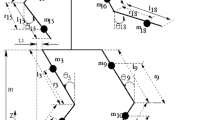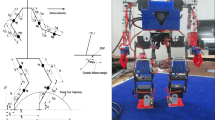Abstract
The crux in designing the PID controller lies in determining its gain values, which play a major role in deciding its performance. The gains are fed as inputs to the controller and are to be decided before its run. On the other hand, the effectiveness of the biped walk purely depends on the performance of the PID controller. Initially, the upper and lower body gaits of the two-legged robot are determined using the concept of inverse kinematics. Further, the dynamics of the biped robot is derived by using Lagrange–Euler formulation. The main objective of the present research is to decide the gains of the torque-based PID controller with the help of a neural network trained by using nature-inspired optimization algorithms, namely MCIWO and PSO. The adaptiveness of the algorithm lies in modifying the gains of the controller based on the magnitude of the error in the angular displacement received at the input to the NN. Once the controller is developed, its effectiveness is tested in computer simulations. Finally, the optimum controlled gait angles obtained by the best approach are tested on a real biped robot.















Similar content being viewed by others
References
Shih CL (1999) Ascending and descending stairs for a biped robot. IEEE Trans Systems Man Cybern A: Syst Hum 29:255–268
Huang Q, Yokoi K, Kajita S, Kaneko K, Arai H, Koyachi N, Tanie K (2001) Planning walking patterns for a biped robot. IEEE Trans Robot Autom 17:280–289
Sugihara T, Nakamura Y, Inoue H (2002) Real time humanoid motion generation through ZMP manipulation based on inverted pendulum control. In: Proceeding of the international conference on robotics and automation, Washington, USA, pp 1404–1409
Kajita S, Kanehiro F, Yokoi K, Hirukawa H (2001) The 3D linear inverted pendulum mode: a simple modeling for a biped walking pattern generation. In: Proceeding of the international conference on intelligent robots and systems, Maui, USA, pp 239–246
Park IW, Kim JY, Lee J, Oh JH (2006) Online free walking trajectory generation for biped humanoid robot KHR-3 (HUBO). Proceeding of the international conference on robotics and automation, Orlando, Florida, USA, pp 1231–1236
Seven U, Akbas T, Fidan KC, Erbatur K (2012) Bipedal robot walking control on inclined planes by fuzzy reference trajectory modification. Soft Comput 16:1959–1976
Chiang MH, Chiang FR (2013) Anthropomorphic design of the human-like walking robot. J Bionic Eng 10:186–193
Ren L, Qian ZH, Ren LQ (2014) Biomechanics of musculoskeletal system and its biomimetic implications: a review. J Bionic Eng 11:159–175
Vukobratovic M, Stepanenko J (1972) On the stability of anthropomorphic systems. Math Biosci 15(1/2):1–37
Goswami A (1999) Foot rotation indicator (FRI) point: a new gait planning tool to evaluate postural stability of biped robots. In: Proceeding of the IEEE international conference on robotics and automation, pp 47–52
Kajita S, Kanehiro F, Kaneko K, Fujiwara K, Harada K, Yokoi K, Hirukawa H (2003) Biped walking pattern generation by using preview control of zero-moment point. In” Proceeding of the IEEE international conference on robotics and automation, pp 1620–1626
Shibuya M, Suzuki T, Ohnishi K (2006) Trajectory planning of biped robot using linear pendulum mode for double support phase. In: Proceeding of the 32nd annual conference of the IEEE industrial electronics society, pp 4094–4099
Erbatur K, Kurt O (2009) Natural ZMP trajectories for biped robot reference generation. IEEE Trans Ind Electron 56(3):835–845
Shih C-L, Chiou C-J (1998) The motion control of a statically stable biped robot on an uneven floor. IEEE Trans Syst Man Cybern B: Cybern 28(2):244–249
Hwang SW, Yeon JS, Park JH (2013) Trajectory generation method for biped robots to climb up an inclined surface. In: 44th international symposium on robotics (ISR), pp 1–5
Cristiano J, Puig D, Garcia MA (2015) Efficient locomotion control of biped robots on unknown sloped surfaces with central pattern generators. Electron Lett 51(3):220–222
Choi T-Y, Park S-Y, Lee J-J (2006) A hybrid SOF-PID controller for a MIMO biped robot. Artif Life Robot 10:69–72
Bouhajar S, Maherzi E, Khraief N, Besbes M, Belghith S (2015) Trajectory generation using predictive PID control for stable walking humanoid robot. Procedia Comput Sci 73:86–93
Anh HPH, Huan TT, Nam NT (2014) Novel robust walking for biped robot using adaptive neural PID controller. In: International conference on automatic control theory and application, pp 86–89
Engelbrecht AP (2007) Computational intelligence: an introduction. Wiley, Hoboken
Shahbazi H, Jamshidi K, Monadjemi AH, Eslami H (2014) Biologically inspired layered learning in humanoid robots. Knowl Syst 57:8–27
Yau TJ, Yun TC, Chih PH (2008) Design of fuzzy PID controllers using modified triangular membership functions. J Inf Sci 178(12):1325–1333
Hang CC, Astrom KJ, Wang QG (2002) Relay feedback auto-tuning of process controllers: a tutorial review. J Process Control 12(1):143–162
Fister D, Fister Jr I, Fister I, Safaric R (2016) Parameter tuning of PID controller with reactive nature-inspired algorithms. Robot Auton Syst 84:64–75
Varol HA, Bingul Z (2004) A new PID tuning technique using ant algorithm. In: Proceeding of the 2004 American Control Conference Boston, Massachusetts
Alcaraz-Jimenez JJ, Herrero-Perez D, Martinez-Barbera H, JJ (2013) A simple feedback controller to reduce angular momentum in ZMP-based gaits. Int J Adv Robot Syst 10:1–7
Aghbali B, Ousefi-Koma AY (2013) ZMP Trajectory control of a humanoid robot using different controllers based on an offline trajectory generation. In: Proceeding of the 2013 RSIIISM international conference on robotics and mechatronics, Tehran, Iran
Kajita S, Morisawa M, Miura K, Nakaoka S, Harada K, Kaneko K, Kanehiro F, Yokoi K (2010) Biped walking stabilization based on linear inverted pendulum tracking. In: The 2010 IEEE/RSJ international conference on intelligent robots and systems, Taipei, Taiwan
Park S, Han Y, Hahn H (2009) Balance control of a biped robot using camera image of reference object. Int J Control Autom Syst 7(1):75–84
Amin AE (2013) A novel classification model for cotton yarn quality based on trained neural network using genetic algorithm. Knowl-Based Syst 39:124–132
Mehrabian AR, Lucas C (2006) A novel numerical optimization algorithm inspired from weed colonization. Ecol Inf 1(4):355–366
Kennedy J, Eberhart R (1995) Particle swarm optimization. Proceedings of IEEE international conference on neural networks, Perth, vol 27, pp 1942–1948
Vundavilli PR, Pratihar DK (2011) Balanced gait generations of a two-legged robot on sloping surface. Sadhana 36(4):525–550
Mousavi PN, Bagheri A (2007) Mathematical simulation of a seven link biped robot on various surfaces and ZMP considerations. Appl Math Model 31:18–37
Ranjbar M, Mayorga RV (2017) A seven link biped robot walking pattern generation on various surfaces. WSEAS Trans Syst 16:299–312
Bagheri A, Miripour-Fard B, Mousavi PN (2010) Mathematical modelling and simulation of combined trajectory paths of a seven link biped robot. Climbing and Walking Robots, Published by Intech Open
Author information
Authors and Affiliations
Corresponding author
Ethics declarations
Conflict of interest
All authors declare that they have no conflict of interest.
Additional information
Publisher's Note
Springer Nature remains neutral with regard to jurisdictional claims in published maps and institutional affiliations.
Rights and permissions
About this article
Cite this article
Mandava, R.K., Vundavilli, P.R. An adaptive PID control algorithm for the two-legged robot walking on a slope. Neural Comput & Applic 32, 3407–3421 (2020). https://doi.org/10.1007/s00521-019-04326-2
Received:
Accepted:
Published:
Issue Date:
DOI: https://doi.org/10.1007/s00521-019-04326-2




